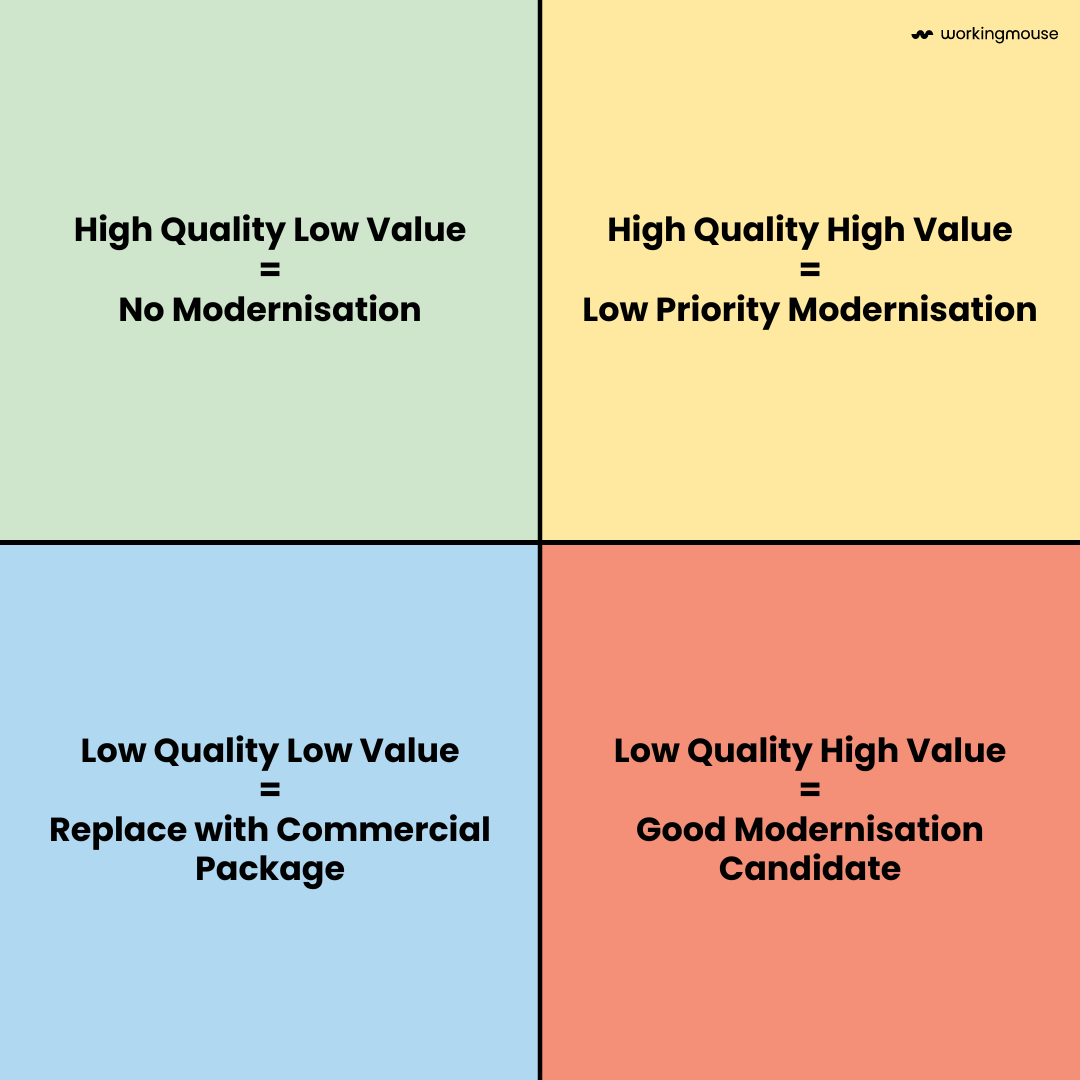
Which Systems to Modernise?
It can be estimated that the cost of supporting legacy systems across all Australian state governments exceeds $160M per year, given that the SA government alone spends over $20M annually [1] and three-quarters of government applications are now over a decade old.
Given the volume of system's it's imperative that as an ICT leader you're aware of and have a strategy to move into a cycle of continuous modernisation if you want to lead towards stage 5 in digital government maturity [2]. So where to start and what to do?
Grouping Legacy Systems
One approach is to select which legacy systems to modernise is to group them into four categories based upon their business value and quality [3].

Figure 1: Legacy System Grouping source. [3]
1. High Quality, High Value = Low Priority Modernisation.
2. High Quality, Low Value = No Modernisation (for now at least)
3. Low Quality, Low Value = Replace with Commercial Package
4. Low Quality, High Value = Good Modernisation Candidate.
This categorisation can help to prioritise and plan the modernisation effort.
Delegating Low-Quality, Low-Value Systems
Low-quality, low-value systems can be delegated for replacement with commercial off-the-shelf systems and data migration. This can help to reduce the complexity and risk associated with modernising these systems, while still achieving the goal of updating them to interact with newer technologies. The key with these systems is to ensure they're not business critical but that data can feed into you warehouse or high value systems.
Prioritising Good Modernisation Candidates
Good modernisation candidates should be prioritised using the risk-to-reward ratio and the six drivers [4]:
1. Business fit: Which systems align to the organisations vision, goals and values?
2. Business value: What will deliver the high business return?
3. Agility: Which systems impact business agility the most?
4. Cost: What is the cost associated presently maintaining that system and how could this be optimised or re-utilised?
5. Complexity: How complex is the system? What and who does is touch, the more touch point, the harder the business change will be.
6. Risk: What is the risk of modernising vs not? Eg. Security risk vs Project risk?
This can help identify the systems that are most likely to provide a high return on investment when modernised and which order they should be approached. Bare in mind that if you bet big before your modernisation efforts have momentum the risk will be greater.
Conducting a Quantitative Analysis
A quantitative analysis should be conducted to compare the costs, benefits, and risks of different modernisation options. Factors to consider include maintenance costs, operational efficiency, and long-term sustainability. This analysis can help to make informed decisions about which systems to modernise and how to approach the modernisation effort.
Collaborate
When selecting which legacy systems to modernise, it is important to align the modernisation effort with the organisation’s business objectives [5]. The most urgent modernisation candidates should be those that are most closely aligned with the organisation’s goals and vision. This will also help buoyant the project against the unexpected by receiving executive buy in.
Conclusion
In conclusion, a major government agency or large enterprise can select which legacy systems to modernise by grouping them into categories, delegating low-quality, low-value systems, prioritising good modernisation candidates, conducting a quantitative analysis, and aligning the modernisation effort with the organization’s business objectives. By following this approach ensures that the modernisation effort is well-planned, cost-effective, and aligned with the organisation’s goals.
References
- SA govt spends $20m-plus on legacy system support each year
- Accelerate Digital for Future-Ready Government
- Building a Systematic Legacy System Modernization Approach by Meena Jha, 2014
- For more details, you can refer to the source article: Legacy System Modernization Guide1.
- Collaborate with stakeholders, including business units, IT teams, and end-users






